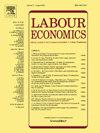是什么决定了学术界的性别薪酬差距?
IF 2.6
2区 经济学
Q2 ECONOMICS
引用次数: 0
摘要
本文主要探讨了两种解释性别工资差距持续存在的机制——工资谈判和儿童惩罚。学术部门的研究使用爱沙尼亚最大的大学塔尔图大学的行政数据。2012年至2021年的学术人员数据已与人口登记和Scopus的网络抓取数据合并。通过使用毕业生的行政记录,得出每个学术领域的外部期权收入,评估谈判的作用,并应用瓦哈卡-布林德分解来评估男性和女性在学术界的工资中是否不同地利用了这种外部期权。学术界的儿童惩罚是使用准实验事件研究方法来估计的,我们利用了我们数据的面板维度。我们发现,在薪酬谈判中,同样的外部选择,男性获得的回报高于女性。鉴于在学术界,男性和女性受到评估和工资谈判的频率相同,我们将这种差距归因于女性的谈判效率较低。我们发现,学术界女性对孩子的惩罚是短暂的,因为她们在分娩后的五年内减少的工作时间相当于两年半的全职工作时间。在小时工资、出版物或引用方面,没有统计上显著的儿童惩罚妇女。相比之下,男性则不会受到任何与孩子有关的惩罚。本文章由计算机程序翻译,如有差异,请以英文原文为准。
What determines the gender pay gap in academia?
This paper focuses on two mechanisms that could explain the persistence of the gender pay gap – salary negotiations and child penalty. The academic sector is studied using administrative data from the University of Tartu, the largest university in Estonia. Data on academic staff from 2012 to 2021 have been merged with the population register and web-scraped data from Scopus. The role of negotiations is evaluated by deriving, for each academic field, their outside option earnings using administrative records of graduates, and the Oaxaca-Blinder decomposition is applied to evaluate whether men and women leverage this outside option differently in their salaries in academia. The child penalty in academia is estimated using a quasi-experimental event-study approach where we exploit the panel dimension of our data. We find that men obtain higher returns than women from the same outside option during salary negotiations. Given that men and women are subject to evaluation and wage negotiations with equal frequency in academia, we assign this gap to women being less effective negotiators. We find the child penalty for women in academia to be short-lived, resulting from a decline in working hours equal to two and a half years of full-time work spread over five years after childbirth. There is no statistically significant child penalty for women in terms of hourly wages, publications, or citations. Men, in contrast, do not experience any penalties related to children.
求助全文
通过发布文献求助,成功后即可免费获取论文全文。
去求助
来源期刊

Labour Economics
ECONOMICS-
CiteScore
3.60
自引率
8.30%
发文量
142
期刊介绍:
Labour Economics is devoted to publishing research in the field of labour economics both on the microeconomic and on the macroeconomic level, in a balanced mix of theory, empirical testing and policy applications. It gives due recognition to analysis and explanation of institutional arrangements of national labour markets and the impact of these institutions on labour market outcomes.
 求助内容:
求助内容: 应助结果提醒方式:
应助结果提醒方式:


